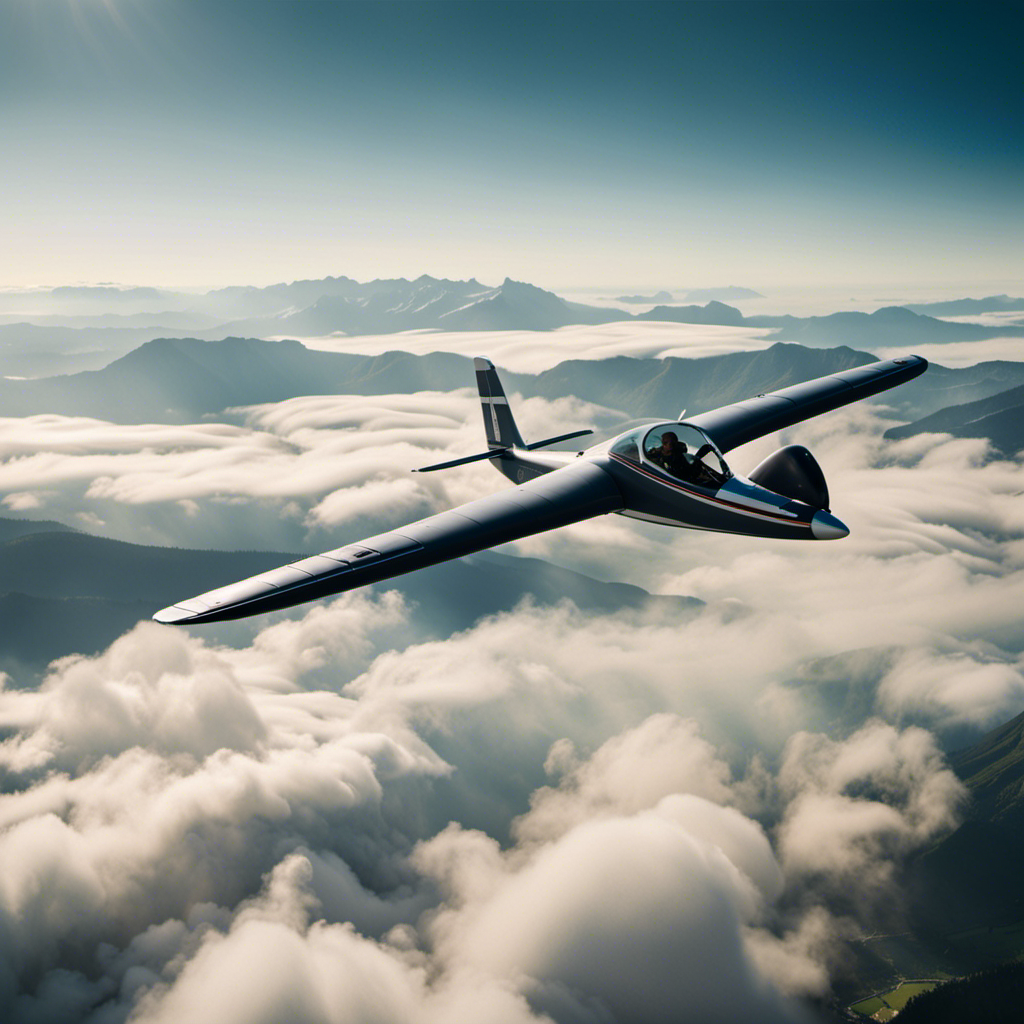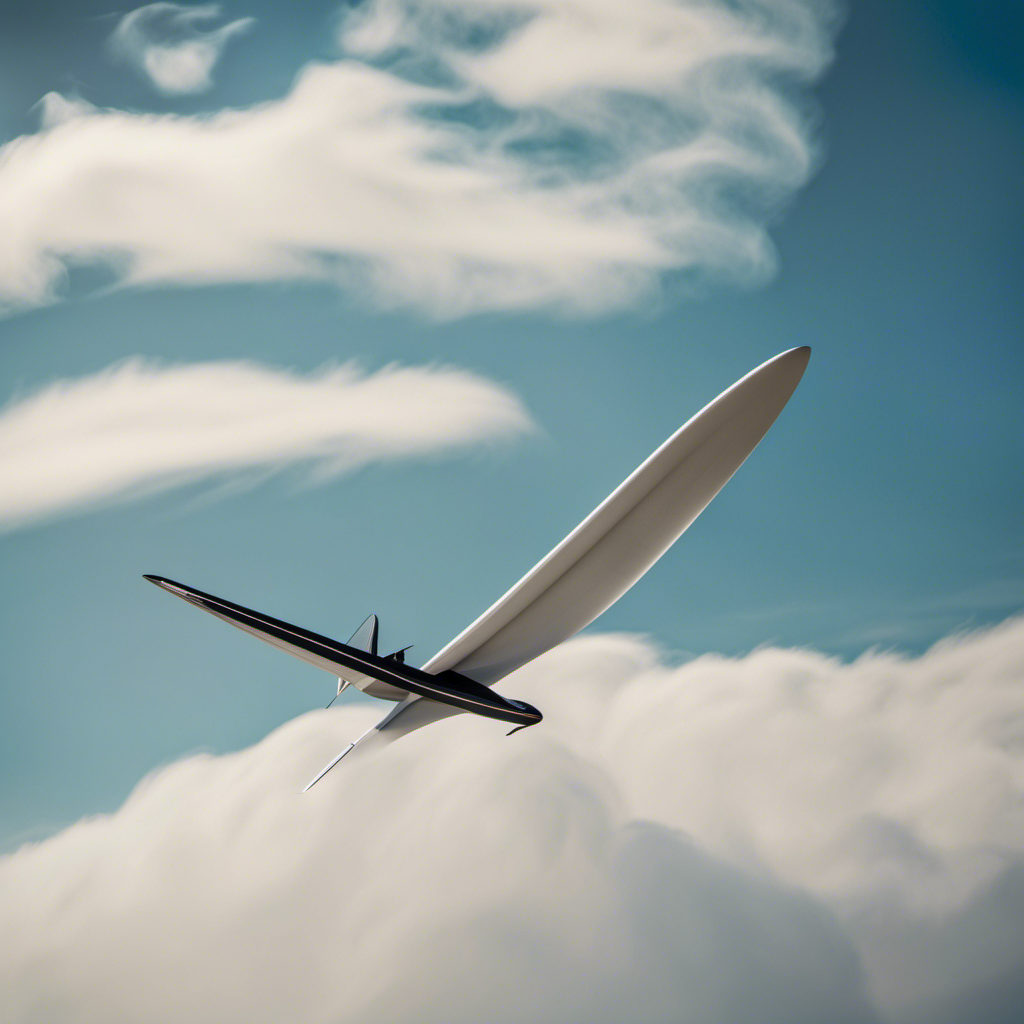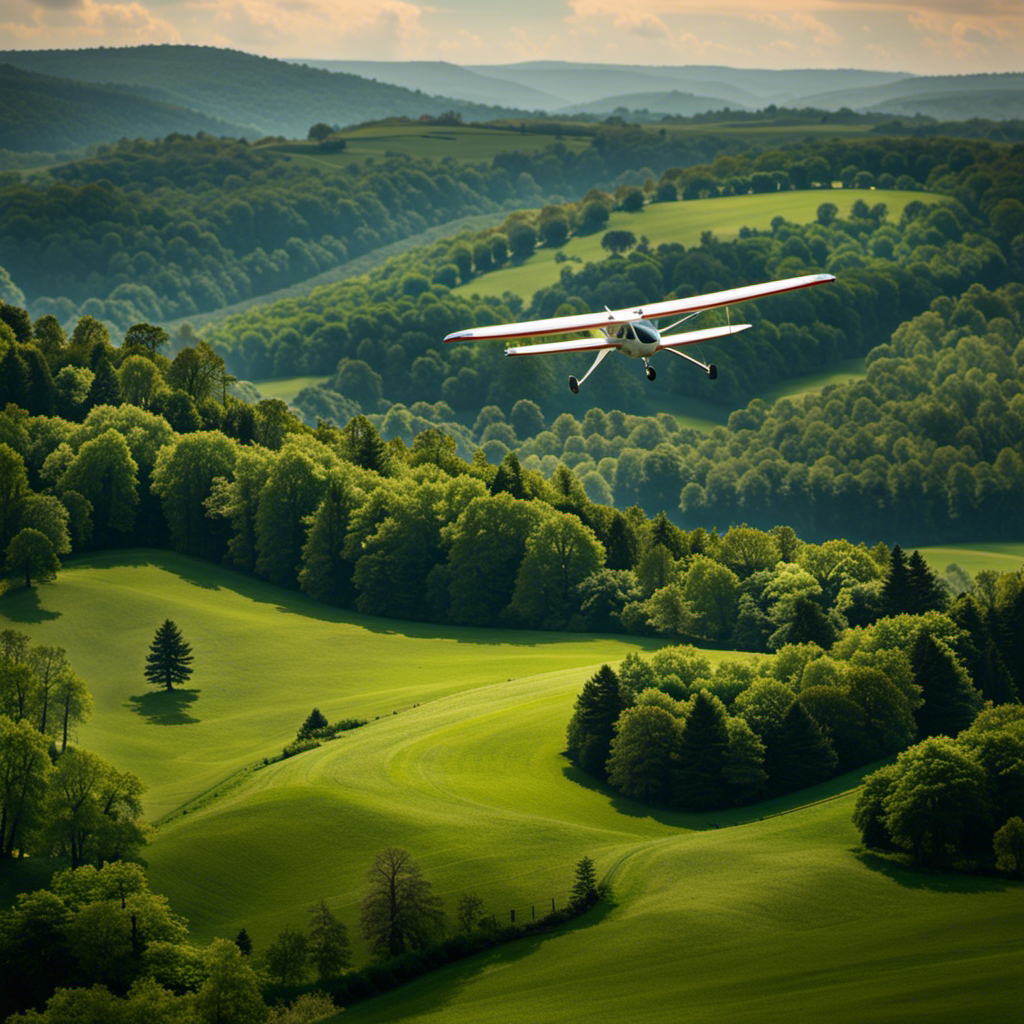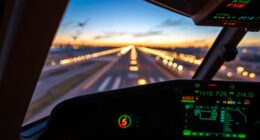I am here to help you achieve your goal of obtaining a glider pilot license from the FAA, even if it may seem like a challenging task.
Strap in and prepare for the ride of a lifetime as we delve into the requirements, training, and application process.
With the guidance of a certified flight instructor and the completion of ground and flight training hours, you’ll be soaring through the skies in no time.
So, let’s embark on this exhilarating journey and unlock the freedom of glider flying together.
Key Takeaways
- Glider pilot training includes both ground instruction and flight training.
- Finding a certified flight instructor (CFI) is the first step towards obtaining a glider pilot license.
- Ground school training covers theoretical aspects of flying and prepares you for obtaining a student pilot certificate.
- Completing flight training hours and passing the FAA practical exam are necessary steps in obtaining a glider pilot license.
Understand the Requirements for a Glider Pilot License
To get a glider pilot license, it’s important to understand all the requirements.
Glider pilot training is essential to gain the necessary skills and knowledge to safely operate a glider aircraft. This training typically includes both ground instruction and flight training.
Ground instruction covers topics such as aerodynamics, meteorology, navigation, and regulations specific to gliders.
Flight training involves hands-on experience in operating a glider, including takeoffs, landings, and various flight maneuvers.
Once the training is complete, the next step is to obtain glider pilot certification. This process typically involves passing a written exam and a practical flight test conducted by a designated examiner.
It is crucial to thoroughly understand and meet all the requirements for glider pilot certification before proceeding to find a certified flight instructor (CFI) who can guide you through the process.
Find a Certified Flight Instructor (CFI)
It’s important to find a CFI who is certified to help you obtain your glider pilot license. Working with a certified flight instructor offers numerous benefits and advantages when it comes to achieving your glider pilot license.
A certified flight instructor has undergone rigorous training and has demonstrated their expertise in teaching and flying gliders. They possess the knowledge and experience to guide you through the entire process, ensuring that you receive the proper instruction and meet all the necessary requirements.
With their guidance, you can develop the necessary skills and knowledge to become a safe and competent glider pilot. A CFI can provide valuable insights, tips, and techniques that will enhance your learning experience and help you progress efficiently.
Finding a qualified CFI is the first step towards achieving your glider pilot license and embarking on an exciting journey in aviation. Now, let’s move on to the next stage, which is completing the ground school training.
Complete Ground School Training
Now that you’ve found a certified flight instructor, completing ground school training is the next step on your journey to becoming a competent glider pilot.
Ground school is where you will learn the theoretical aspects of flying, including aerodynamics, meteorology, navigation, and regulations. To ensure a comprehensive education, the ground school curriculum typically covers a wide range of topics, such as principles of flight, flight instruments, airspace classifications, emergency procedures, and glider performance.
Study materials for ground school may include textbooks, online courses, instructional videos, and practice exams. It is important to dedicate sufficient time and effort to studying these materials, as they provide the foundation for your practical flight training.
Once you have completed ground school, you will be well-prepared to move on to the next phase of your journey: obtaining a student pilot certificate, which will allow you to start your hands-on training in the glider.
Obtain a Student Pilot Certificate
Before you can start your hands-on training in the glider, you’ll need to obtain a student pilot certificate. This certificate is issued by the Federal Aviation Administration (FAA) and serves as proof that you have met the necessary requirements to begin your glider pilot training.
To obtain the student pilot certificate, you must be at least 14 years old and have the ability to read, speak, and understand English. You will also need to pass a medical examination conducted by an FAA-approved aviation medical examiner.
Once you have obtained your student pilot certificate, you can then proceed with your glider pilot training. This certificate is the first step towards achieving your goal of becoming a licensed glider pilot.
Transitioning into the subsequent section about ‘complete flight training hours’, obtaining a student pilot certificate is just the beginning of your journey. Now that you have the necessary documentation, you can move on to accumulating the required flight training hours to become a certified glider pilot.
Complete Flight Training Hours
To reach your goal of becoming a certified glider pilot, you’ll need to log a specific number of flight training hours. Here’s what you need to know about completing your flight training hours:
-
Enroll in a reputable flight training school: Choose a school that specializes in glider training and has experienced instructors who can provide you with the necessary knowledge and skills.
-
Follow a structured training program: A well-structured program will ensure that you receive comprehensive instruction in areas such as pre-flight checks, takeoff and landing techniques, emergency procedures, and navigation.
-
Gain practical flight experience: The more time you spend in the cockpit, the better you will become. Aim to accumulate the required number of flight hours through a combination of solo flights and dual flights with an instructor.
-
Keep a flight training log: Document each flight hour, including the date, duration, type of flight, and any specific skills practiced or learned.
Pass the FAA Practical Exam
In order to become a certified glider pilot, you’ll need to successfully pass the FAA practical exam. This exam is designed to test your knowledge and skills in various aspects of glider flying. To help you prepare for this important milestone, here are some passing techniques and practical exam tips:
| Passing Techniques | Practical Exam Tips | Study Materials | Practice |
|---|---|---|---|
| Review FAA regulations | Familiarize yourself with the exam format | FAA Handbooks | Take practice exams |
| Practice flight maneuvers | Develop a thorough understanding of glider systems | Online resources | Fly with an instructor |
| Maintain good situational awareness | Master emergency procedures | Study groups | Simulate exam conditions |
Apply for a Glider Pilot License
To apply for a glider pilot license, there are several key steps you need to follow.
First, you must gather all the necessary documentation, including your identification, medical certificate, and proof of training.
Once you have all the required paperwork, you can then submit your application to the FAA, either online or through mail.
Gather Required Documentation
You’ll need to gather your required documentation for your glider pilot license, such as your proof of identification and medical certificate.
Glider pilot training is a rigorous process that requires thorough preparation and adherence to the necessary paperwork.
To start, you must provide a valid proof of identification, typically in the form of a government-issued ID card or passport.
Additionally, you’ll need a medical certificate from an FAA-approved aviation medical examiner to ensure you meet the physical requirements for flying a glider.
This certificate verifies that you are in good health and capable of safely operating an aircraft.
Once you have collected all the necessary documentation, you can proceed to submit the application to the FAA, making sure to include all the required paperwork.
This will initiate the next step in the process of obtaining your glider pilot license.
Submit the Application to the FAA
Once you’ve gathered all the required documentation, it’s time to submit your application to the FAA. The submission of your application is a crucial step in the process of obtaining a glider pilot license.
The FAA has specific requirements that must be met in order for your application to be considered valid. These requirements include completing the appropriate application form, providing proof of age and citizenship, and submitting any necessary medical certificates.
It is important to carefully review the FAA’s guidelines and instructions to ensure that your application is complete and accurate. Once you have compiled all the necessary documents and filled out the application form, you can submit it to the FAA for review.
After submitting your application, the next step is to pay the necessary fees.
Pay the Necessary Fees
After submitting the application to the FAA, it is crucial to pay the necessary fees to proceed with obtaining a glider pilot license.
The FAA requires applicants to fulfill specific financial requirements to cover administrative costs and ensure the validity of the certification process. These fees vary depending on the type of license and the services required.
As a prospective glider pilot, it is essential to carefully review the FAA’s guidelines to determine the exact amount and payment methods accepted. Failure to pay the fees may result in delays or even the rejection of your application.
Once the fees are paid and processed, you can move forward with the next steps to maintain your glider pilot license, ensuring your continued ability to take to the skies.
Maintain Your Glider Pilot License
As a glider pilot, it’s crucial for me to maintain my license by fulfilling certain requirements.
These requirements include completing regular flight reviews to ensure my skills and knowledge are up to date.
Additionally, staying current with FAA regulations is essential to ensure compliance and safety in the air.
Lastly, continuously improving my skills and knowledge through practice and education will enable me to become a better and safer pilot.
Complete Regular Flight Reviews
To maintain a glider pilot license, it’s important to regularly complete flight reviews.
Flight reviews are a crucial part of the regular flight review process for glider pilots. These reviews help ensure that pilots stay current, proficient, and safe in their flying skills.
By undergoing regular flight reviews, pilots are able to assess their knowledge and abilities, identify areas for improvement, and receive feedback from qualified instructors. This continuous learning process contributes to the overall safety and professionalism of glider pilots.
Regular flight reviews also provide an opportunity for pilots to stay up-to-date with the latest industry standards, regulations, and best practices. By staying current with FAA regulations, pilots can ensure that they are always operating within the legal framework and maintaining the highest level of safety in their flying activities.
Stay Current with FAA Regulations
Staying current with FAA regulations is essential for glider pilots to ensure their flying activities are safe and legal. As a glider pilot, I understand the importance of staying up to date with the ever-changing regulations set by the FAA. Here are five key ways to stay informed and compliant:
- Regularly check the FAA website for updates and changes to regulations.
- Subscribe to FAA email notifications to receive timely information about new regulations.
- Join aviation forums and online communities to stay connected with other pilots and discuss regulatory changes.
- Attend FAA seminars and workshops to gain valuable insights and knowledge about current regulations.
- Consult with a certified flight instructor or aviation lawyer to clarify any questions or concerns about specific regulations.
By staying informed about airspace restrictions and other regulations, glider pilots can operate safely and confidently in the skies.
As we transition into the subsequent section on continuously improving skills and knowledge, it is crucial to understand that staying current with FAA regulations is just the first step in becoming a proficient and responsible glider pilot.
Continuously Improve Your Skills and Knowledge
Improving my skills and knowledge is an ongoing process as a glider pilot. To become a better pilot, it is crucial to continuously work on improving my skills and gaining knowledge.
One way to achieve this is by regularly practicing flying maneuvers and techniques. By dedicating time to hone my skills, I can become more proficient in handling the glider in different conditions and scenarios.
Additionally, staying up to date with the latest advancements and research in the field of glider aviation enables me to expand my knowledge base. This could include reading books, attending workshops, or participating in online forums.
By continuously improving my skills and gaining knowledge, I can become a more competent and confident glider pilot.
Transition: In addition to continuously improving my skills and knowledge, another important aspect of becoming a proficient glider pilot is to join a glider club or association.
Join a Glider Club or Association
Joining a glider club or association is a great way to connect with other pilots and gain valuable experience. Being part of a glider club offers numerous benefits that can enhance your journey as a pilot. Here are a few reasons why joining a glider club is a worthwhile investment:
-
Access to a supportive community of fellow pilots who share your passion for glider flying, providing a sense of camaraderie and friendship.
-
Opportunities to participate in group flights, competitions, and events, allowing you to challenge yourself and improve your skills.
-
Discounts on glider rentals, instruction fees, and equipment purchases, helping to offset the costs associated with glider flying.
By becoming a member of a glider club, you not only gain access to a wealth of knowledge and resources, but you also become part of a tight-knit community that shares your love for soaring through the skies.
Now, let’s explore how you can enjoy the freedom of glider flying.
Enjoy the Freedom of Glider Flying
As a glider pilot, I have had the opportunity to explore different glider flying locations, each offering unique challenges and breathtaking scenic views.
Planning exciting cross-country flights allows me to put my skills to the test and experience the thrill of soaring through the sky for long distances.
Sharing my passion for glider flying with others is a rewarding experience, as it allows me to inspire and educate others about this exhilarating and environmentally friendly form of aviation.
Explore Different Glider Flying Locations
You’ll want to visit various glider flying locations to see which ones suit your preferences. Exploring different glider flying locations allows you to not only experience the thrill of gliding but also discover hidden launch sites and explore scenic landscapes. To help you in your search, I have compiled a table showcasing four exceptional glider flying locations:
| Location | Scenic Landscapes | Hidden Launch Sites |
|---|---|---|
| Mountain Range | Majestic peaks and valleys | Remote mountain meadows |
| Coastal Cliffs | Breathtaking ocean views | Secluded beach launch sites |
| Desert Oasis | Vast sand dunes | Oasis-based launch areas |
| Forest Canopy | Lush greenery | Forest clearings |
Plan Exciting Cross-Country Flights
Now that we have explored different glider flying locations, let’s delve into the exciting world of planning cross-country flights.
As a glider pilot, there is nothing quite like the thrill of soaring through the sky, covering long distances without an engine. Planning cross-country flights involves selecting exciting routes that offer both picturesque views and favorable weather conditions.
It is essential to consider factors such as wind patterns, cloud formations, and thermal activity to ensure a safe and enjoyable journey. By analyzing weather forecasts, studying topographical maps, and consulting with experienced pilots, I can carefully plan my route to maximize the potential for dynamic soaring and extended flights.
With this knowledge, I can now share my passion for glider flying with others, inspiring them to experience the incredible freedom of soaring through the heavens.
Share Your Passion for Glider Flying with Others
By sharing my love for glider flying, I can inspire others to experience the incredible freedom of soaring through the heavens. Glider flying is not just a hobby, but a way of life that has given me unforgettable moments and a deep connection to the sky. Here are three reasons why sharing experiences and connecting with fellow glider pilots is so important:
-
Inspiration: Sharing my glider flying experiences can inspire others to pursue their own dreams of flying. By sharing the thrill and joy of soaring through the air, I can ignite a passion in others and show them what is possible.
-
Community: Connecting with fellow glider pilots allows for the exchange of knowledge, tips, and experiences. It creates a supportive community where we can learn from each other and grow as pilots.
-
Safety: By sharing experiences, we can also learn from each other’s mistakes and successes, enhancing safety in the gliding community. We can discuss techniques, weather conditions, and best practices, ensuring a safer and more enjoyable flying experience for everyone involved.
Frequently Asked Questions
Are there any age restrictions for obtaining a glider pilot license?
There are no age restrictions for obtaining a glider pilot license in the United States. However, it is important to note that international requirements may vary, so it is recommended to check with the respective aviation authority.
How long does it typically take to complete ground school training?
On average, ground school training for a glider pilot license takes about 6-8 weeks. This training is essential as it covers topics such as aerodynamics, weather, navigation, and emergency procedures, providing a solid foundation for safe and effective glider flying.
Can I use my student pilot certificate to fly gliders in other countries?
Yes, you can use your student pilot certificate internationally to fly gliders in other countries. However, it is important to research and understand the specific requirements and regulations for flying gliders in each country you plan to visit.
What are the medical requirements for obtaining a glider pilot license?
To obtain a glider pilot license, I must meet certain medical requirements. These requirements ensure that I am physically fit to operate a glider safely. They include vision, hearing, and general health assessments.
Are there any additional endorsements or ratings available for glider pilots?
As a glider pilot, I’ve discovered a world of opportunities beyond just obtaining my license. There are additional endorsements and ratings available for glider pilots, allowing us to expand our skills and explore new experiences in the sky.
Conclusion
In conclusion, obtaining a Glider Pilot License from the FAA requires dedication, training, and a passion for the open skies. It’s a process that involves understanding requirements, finding a CFI, completing ground and flight training, and applying for the license.
Maintaining the license and joining a glider club or association are important for continuous growth in this exhilarating sport. So soar high, savor the serenity, and seize the opportunity to experience the freedom of glider flying.
Fly fearlessly and fulfill your dreams!
With a heart that soars as high as the skies, Aria, affectionately known as “Skylark,” is the driving force behind Soaring Skyways. Her journey into the gliding world began as a young dreamer gazing up at the soaring birds, yearning to experience the weightlessness and freedom they embodied. With years of experience both in the cockpit and behind the scenes, Aria’s commitment to the gliding community is unwavering.










